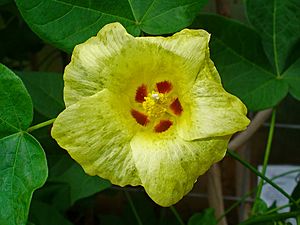Gossypium facts for kids
Quick facts for kids Cotton plant |
|
|---|---|
 |
|
| Flower of Gossypium herbaceum | |
| Scientific classification |
|
| Kingdom: | Plantae |
| Clade: | Tracheophytes |
| Clade: | Angiosperms |
| Clade: | Eudicots |
| Clade: | Rosids |
| Order: | Malvales |
| Family: | Malvaceae |
| Subfamily: | Malvoideae |
| Tribe: | Gossypieae |
| Genus: | Gossypium L. |
| Type species | |
| Gossypium arboreum |
|
| Species | |
|
See text. |
|
| Synonyms | |
|
|
Gossypium is a group of flowering plants that gives us cotton. These plants belong to the mallow family, called Malvaceae. You can find them in warm, sunny parts of the world, like Africa, South America, and Asia. There are about 50 different kinds of Gossypium plants. The word goz in Arabic means "soft substance," which is where the name Gossypium comes from.
Cotton is super important! It's the main natural fiber people use today. About 80% of all natural fibers come from cotton. Besides making clothes, cotton plants also give us oil from their seeds. The leftover parts are used to feed animals. This makes cotton a very valuable plant for farming and trade, especially in tropical and subtropical countries.
Contents
What is the Cotton Plant?
The Gossypium genus started growing about 5 to 10 million years ago. These plants usually grow in dry or semi-dry areas. Most cotton plants are shrubs, which are like small bushes. But some can be herbaceous (meaning they have soft stems) or even trees.
Most wild cotton plants have two sets of chromosomes. This is called being "diploid." But five special types from America and Pacific islands have four sets of chromosomes. These are called "tetraploid" species. They include G. hirsutum, G. tomentosum, G. mustelinum, G. barbadense, and G. darwinii.
How Cotton Grows
Cultivated cotton plants are usually grown as annual plants, meaning they live for only one year. They can grow to be 1 to 2 meters (about 3 to 6 feet) tall. Their leaves are wide and have three to five lobes, like fingers.
The seeds of the cotton plant are inside a special fruit called a "boll." Each seed is covered in soft fibers. These fibers are the part we use! Farmers separate the fibers from the seeds in a process called ginning.
- First Ginning: The longer fibers, called "staples," are removed. These are twisted into yarn to make strong threads and high-quality fabrics.
- Second Ginning: Shorter fibers, called "linters," are removed. These are used for lower-quality fabrics.
The most common types of cotton grown around the world are:
- G. hirsutum (over 90% of all cotton)
- G. barbadense (3–4%)
- G. arboreum and G. herbaceum (together, 2%)
Scientists are always working to make cotton plants even better. They try to breed new types that can fight off insects and diseases or grow well with less water. Cotton fibers naturally come in white, brown, and green colors.
Types of Cotton Plants
Here are some selected types of Gossypium plants:
Subgenus Gossypium
- Gossypium arboreum – This is a tree cotton found in India and Pakistan.
- Gossypium herbaceum – Also known as Levant cotton, it grows in southern Africa and the Arabian Peninsula.
Subgenus Houzingenia
- Gossypium raimondii – This plant is thought to be one of the ancestors of the tetraploid cottons.
- Gossypium thurberi – Called Arizona wild cotton, it grows in Arizona and northern Mexico.
Subgenus Karpas
- Gossypium barbadense – Known as Creole cotton or Sea Island Cotton, it's found in tropical South America.
- Gossypium darwinii – Darwin's cotton, found in the Galápagos Islands.
- Gossypium hirsutum – This is upland cotton, common in Central America, Mexico, the Caribbean, and southern Florida.
- Gossypium mustelinum
- Gossypium tomentosum – Also called Maʻo or Hawaiian cotton, it grows in Hawaii.
Subgenus Sturtia
- Gossypium australe – Found in northwestern Australia.
- Gossypium sturtianum – Known as Sturt's desert rose, also from Australia.
Plants Formerly in Gossypium
Some plants used to be grouped with Gossypium but are now in different groups:
- Gossypioides brevilanatum
- Gossypioides kirkii
- Kokia drynarioides
Cotton Pests and Diseases
Like all plants, cotton can be attacked by pests and diseases. Farmers work hard to protect their crops.

Pests
Pests are insects or other small creatures that harm the plants.
- Boll weevil: A small beetle that eats cotton bolls.
- Cotton aphid: Tiny insects that suck sap from the plant.
- Cotton stainer: An insect that stains the cotton fibers.
- Cotton bollworm and native budworm: These are caterpillars that munch on cotton crops. Many other Lepidoptera (butterflies and moths) larvae also feed on cotton.
- Green mirid: A sucking insect.
- Spider mites: Tiny mites that can damage leaves.
- Thrips: Small insects that feed on plant tissues.
Diseases
Diseases are caused by tiny fungi or bacteria that make the plant sick.
- Alternaria leaf spot: Causes spots on the leaves.
- Anthracnose boll rot: Causes the cotton boll to rot.
- Black root rot: A fungus that attacks the roots.
- Blight: Causes parts of the plant to wither and die.
- Fusarium boll rot: Another type of boll rot caused by fungi.
- Phytophthora boll rot: Yet another boll rot, also caused by a fungus.
- Sclerotinia boll rot: A fungus that causes rot.
- Stigmatomycosis: A disease caused by certain fungi.
Gallery
-
A Gossypium hirsutum flower, side view, growing in Barcelona
-
G. hirsutum flower with bumblebee pollinator, Hemingway, South Carolina
-
Integrated pest management bollworm trap at a cotton field in Manning, South Carolina
-
Natural biocontrol: predatory Polistes wasp looking for bollworms or other caterpillars on cotton plant in Hemingway, South Carolina
-
Gossypium boll ready for harvest, South Carolina
See also
 In Spanish: Gossypium para niños
In Spanish: Gossypium para niños










